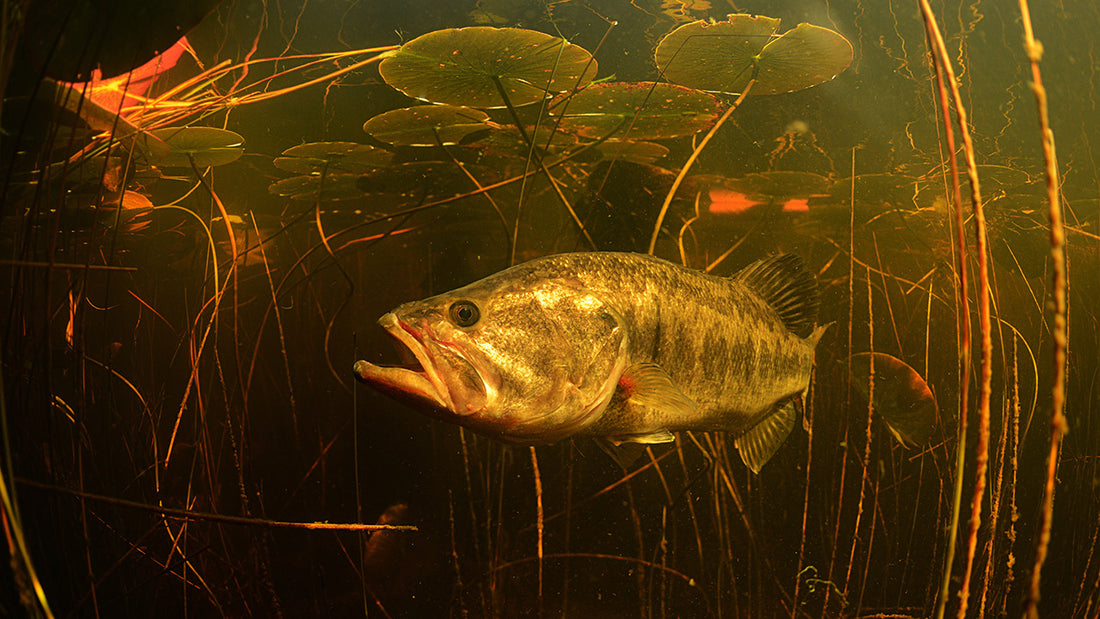
Species Spotlight: Largemouth Bass
LARGEMOUTH BASS
Micropterus salmoides

Calling the largemouth the single most popularly targeted game fish in the world seems like a fairly safe bet. Among the reasons for this are its aggressive nature, hard strike, occasional gill-rattling leaps and — particularly — the proclivity of this hardy species to thrive just about anywhere and everywhere. Once found only in its native region of eastern North America, it’s now one game fish you can catch in all 50 states. It supports active sport fisheries around the world in locations such as Japan, China, Russia, most western European countries and many African nations as well. The economic importance of this species is remarkable. It lives happily in lakes and slower rivers ranging from tropical areas to hard, cold arctic regions near the poles. The largemouth (aka black bass) is the largest member of the sunfish family, Centrarchidae.

Appearance
Its dark greenish color is less bronze than its only other large cousin, the smallmouth. The latter also has dark bars on its sides and no break in the soft and spiny sections of the dorsal fin, whereas the largemouth has a distinct notch separating the two dorsal fins. Their respective names are less about the size of their mouth than how far back the jaw extends on the gill cover — beyond the back of the eye on the largemouth but only as far as the eye on the smallie.
Habitat
Likely to be in most any lake, pond, slow-moving river or backwaters, typically, the largemouth loves weeds and/or structure, though at times schools of (often smaller) fish will bust schools of baitfish on top in open water. They’re not fond of much current and prefer water in the 60s, 70s and even 80s (Fahrenheit). They may range into fairly deep water, but during spring spawning — when they’re said to be bedding — they’ll be in water no more than a few feet deep, guarding concave nests they’ve formed in a sandy or gravel bottom.
Size
Bass enthusiasts have dreamed for decades of breaking the IGFA all-tackle largemouth world record of 22 pounds, 4 ounces, caught in 1932 in Montgomery Lake, Georgia, by George Perry. That record has never been broken, but in 2009, it was officially tied by a 22-pound, 4-ounce bass from Lake Biwa in Japan by Manabu Kurita. Largemouth grow to a greater average size in warmer southern lakes, where they’ll reach roughly five pounds in five years. In northern lakes with hard winters the same bass could take more than 10 years to reach that size.
Pros
Active predators that strike great variety of soft and hard lures as well as live bait, their fight often includes impressive jumps. This species thrives in most lakes and ponds.
Cons
Fight may be brief, particularly when caught from heavy cover requiring 30- to 60-pound braided line. High level of popularity may in some waters lead to populations of wary, lure-savvy larger fish.

Pro's Tips For Targeting largemouth
BASS Elite Series angler Mike Iaconelli is a past winner of the Bassmaster Classic Championship and a Toyota Elite Series Angler of the Year, and by any definition one of the country’s leading bass pros. He shared a few tips in this AFTCO exclusive.
Use Google Before you ever visit any lake or stream to find out what you can about the main forage there. Type that request into your search engine; sometimes you can take away some great insight. (Probably best results on larger, better-known waters.) Once you know the main forage, you can try to match the hatch with lures that imitate what bass want.
Match The Hatch not just the shape/silhouette of the forage but its movements: The action you impart should imitate the movement of that fish or crustacean in nature.
Carry Some Spike-It or similar markers to customize soft plastics in situ. For example, Iaconelli has been known to color the head of a green-pumpkin Seiko worm or similar to make it more closely resemble a crawfish.
Color Matters — but only to a point. That is, Iaconelli says what’s critical is finding/using the right color palette. The fish may be favoring lighter shades (of various colors) or darker. Green may be hot but can include many shades/variations of green. “You don’t need hundreds of colors,” he says, but you do need to have shades available from various color palettes.






